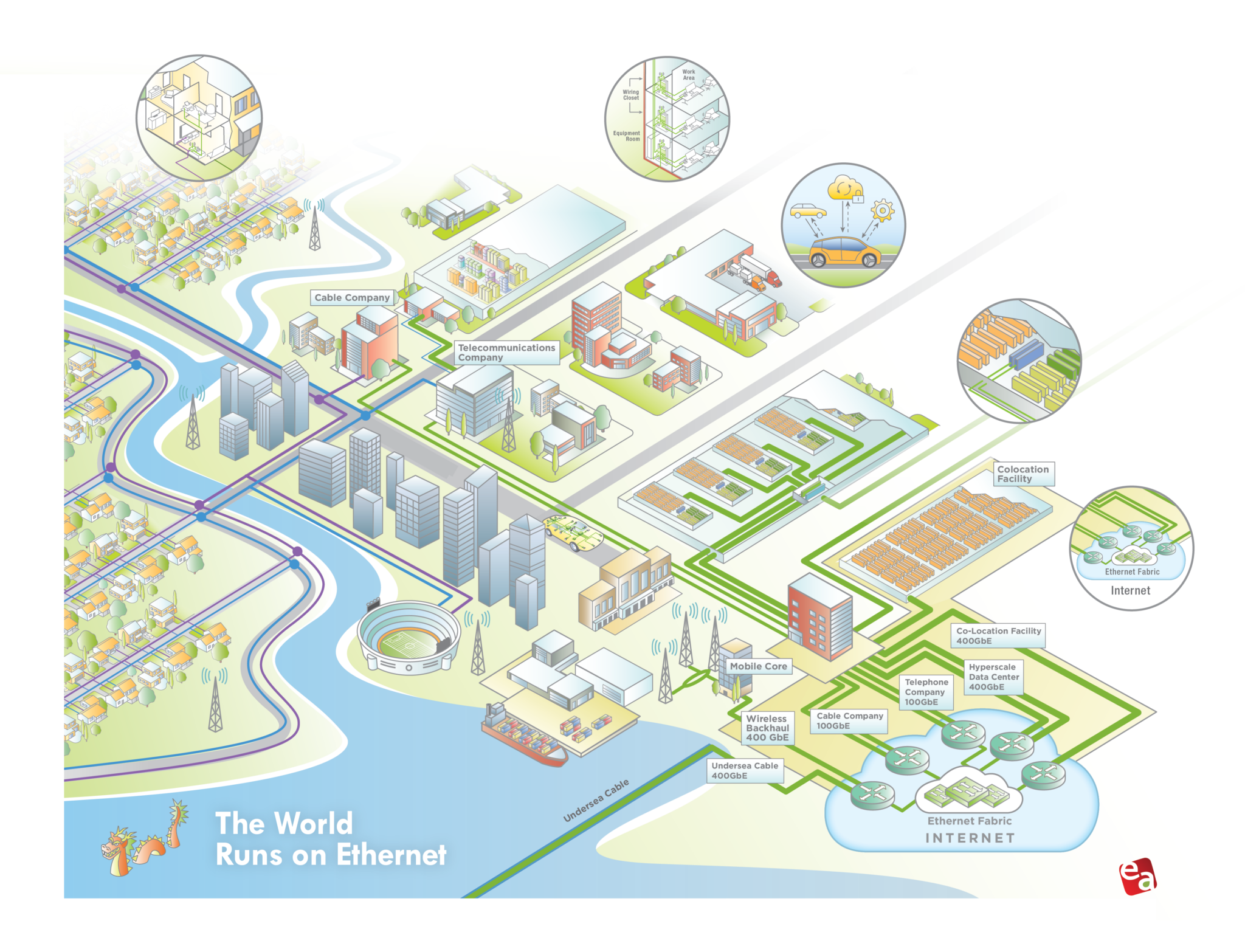Ethernet Still Going Strong at 50
A half century after its inception, this ground-breaking technology is still a major player in the evolving world of connectivity.

Image courtesy of Ethernet Alliance.
In May 1973, Xerox PARC (Palo Alto Research Center) researcher Bob Metcalfe sent out a memo that outlined a new broadcast communication network to connect computers within a building. His design used coaxial cable, but envisioned communication via an “ether.” The concept made his idea adaptable to numerous future innovations. Media such as optical fiber, radio (Wi-Fi), and even power networks would become the ether that replaced the coaxial cable, creating what is known today as the Ethernet. This year marks the 50th anniversary of this ground-breaking technology that is still highly relevant in the evolving world of connectivity.
Ethernet is a set of wired computer networking technologies used with LAN (local area networks) and WAN (wide area networks). Metcalfe’s Ethernet allowed multiple computers to talk using a shared coaxial cable. The earliest version ran at 2.94 megabits per second, which was about 10,000 times faster than the terminal networks it would replace, but it was unpredictable — just two computers talking at the same time was enough to cause a network delay. In a few short years, however, Ethernet was commercially introduced, and in 1983 it was standardized as IEEE 802.3.

Amphenol Socapex RJF TV Ethernet connectors from Mouser allow the use of an Ethernet Class D/Cat 5e, Cat6, and Cat6A connection for 10 BaseT, 100 BaseTX, or 1000 BaseT networks in harsh environments.
As markets embraced the technology, the Ethernet Alliance has worked to find solutions for new applications. “Scaling from 10 Mb/s to now 800 Gb/s during the past 50 years, Ethernet continues to surprise and surpass competitive technologies by creating a more efficient whole network architecture from the data center to edge devices,” said David J. Rodgers, chair, Ethernet Alliance Events & Conferences Committee.
Some of the keys to Ethernet’s longevity and success are its resilience, openness, interoperability, and adaptability. “Ethernet constantly evolves to address new use cases – moving data from the cloud to the edge to serve an increasingly smart and connected world,” said Sam Johnson, high-speed networking (HSN) subcommittee co-chair, Ethernet Alliance.
Ethernet in the wireless era
Although Wi-Fi has proliferated, Ethernet remains in demand. Despite the obvious advantages associated with wireless connectivity, wired connections have a place in settings where Wi-Fi falls short, such as locations where high signal traffic compromises speed and reliability, or where physical barriers like walls and floors interfere with signal transmissions. Ethernet connections are also more secure because access is limited to the local network, whereas Wi-Fi is transmitted over airwaves and can potentially be accessed by anyone within range of the Wi-Fi hotspot. Even Wi-Fi routers require an Ethernet cable to connect to a phone line.

The 2023 Ethernet Roadmap highlights building and industrial automation, automotive, enterprise, service providers, and cloud providers as important and growing markets. Source: Ethernet Alliance.
Consumer electronics that require greater security or speed can benefit from a wired Ethernet connection. Schools, hospitals, company headquarters, and others that operate via a local network continue to use Ethernet for its dependability, speed, and security. Ethernet is advancing the field of industrial automation as well. Smart factories employ SCADA systems that rely on data collection at nearly every stage of operation to monitor production and maximize efficiency.

HARTING’sT1 industrial connectivity solution was designed to be the standard interface for industrial single-pair Ethernet applications.
One new iteration, single-pair Ethernet (SPE), brings the technology to the factory floor. The transmission of Ethernet via just one pair of copper wires to connect field devices to the Ethernet network is possible with single-pair cabling that is fast, space-saving, cost-effective and easy to implement. By equipping simple sensors and cameras with Ethernet interfaces, SPE is driving Integrated Industry and IIoT.
“Ethernet is so resilient because it has the flexibility to operate over multiple speeds and media supporting a wide range of industries and network types, while maintaining a strict standards creation process to ensure that technologies will interoperate, perform as expected in the real world, and deliver high-quality user experiences,” said Dave Estes, Ethernet Alliance board member.
The Ethernet Alliance takes Ethernet standards to market by supporting incubation of new Ethernet technologies, interoperability demonstrations, and education. Earlier this month, the organization hosted a multivendor interoperability demonstration at the 2023 European Conference on Optical Communication (ECOC) in Glasgow, Scotland, showcasing a half-century of proven success with the latest advancements in speeds and next-generation technologies.
Fifty years after that now famous memo, the Association for Computing Machinery, the world’s largest society of computing professionals, named Metcalfe the recipient of the 2022 A.M. Turing Award, often called the Nobel Prize of computing. 3Com, Metcalfe’s 1979 Silicon Valley startup helped increase the commercial viability of Ethernet by selling network software, Ethernet transceivers, and Ethernet cards for minicomputers and workstations. 3Com introduced one of the first Ethernet interfaces for IBM PCs and their clones when IBM launched its personal computer.
Read about a new biography of Mark Weiser, another Xerox PARC innovator.
Like this article? Check out our other articles on Cable, Ethernet, our Wire and Cable Assemblies Market Page, and our 2023 and Article Archive.
Subscribe to our weekly e-newsletters, follow us on LinkedIn, Twitter, and Facebook, and check out our eBook archives for more applicable, expert-informed connectivity content.
- Sealing Success: Overmolding for More Secure Connections - April 23, 2024
- Medical Cable Assemblies Product Roundup - April 23, 2024
- Mezzanine Connectors Product Roundup - April 16, 2024





